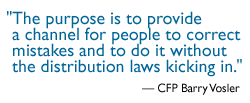|
IRA switcheroo
|
 |
July 11, 2000: 7:29 a.m. ET
Here's how to change your Roth IRA back to a traditional plan
By Staff Writer Jennifer Karchmer
|
NEW YORK (CNNfn) - OK, it's a little complicated, and not all that sexy, but this rule could save you a headache if you want to switch your Roth IRA back to a traditional plan.
Let's say you wanted to take advantage of the Roth IRA and you converted your IRA last year. But now you realize your income exceeds the eligibility requirements for the Roth, so you'll need to change it back to the traditional IRA.
Under recharacterization, which allows you to switch your IRA plan without paying penalties or withdrawal fees, the second plan is treated as if it received the original contribution. 
"The purpose (of recharacterization) is to provide a channel for people to correct mistakes, to do it without the distribution laws kicking in place," said Barry Vosler, a certified financial planner (CFP). "It gives the investor an option to go back in time and make a change to his IRA."
Who chooses it?
Let's say you're a 30-year-old investor who had been investing in a traditional IRA and converted it to a Roth last year. (Most advisers have suggested to you to open a Roth IRA because you're paying taxes now instead of later during your retirement years.)
But after you received a sweet year-end bonus, you realize that it's pushed your adjusted gross income, which is your annual salary plus any taxable income such as investment dividends, capital gains, or self-employment income, over the $100,000 limit for a Roth contribution.
Under the recharacter rule, you can substitute a traditional IRA for the Roth and you'll be treated as if the contribution went to the traditional IRA.

CFP Bob Fitzsimmons advised one of his clients -- a farmer who exceeded the $100,000 limit -- to recharacterize his Roth IRA back to a traditional IRA.
"We found out he exceed the $100,000 test, and he said, 'Yikes!' I've got to get that reconverted," said Fitzsimmons who works in Lincoln, Neb.
What to do
Recharacterizing, or switching, your IRA involves changing your contribution from one IRA to another so the first thing you need to do is set up a new IRA.
You can do this with the same company as the original IRA or with a new mutual fund provider.
The thing to remember is that the transfer must go directly from one IRA to another, making it a trustee-to-trustee transfer. So contact your mutual fund company that runs your IRA and ask for a recharacterization form.
Here are some reasons why you might want to recharacterize your Roth contribution or conversion:
- You converted to a Roth IRA but your modified adjusted gross income (AGI) turned out to be greater than $100,000 for the 1999 tax year.
- You converted to a Roth IRA but are married filing separately for your 1999 tax return.
- You contributed to a Roth IRA in 1999, but you were ineligible because you are married filing jointly and your adjusted gross income was greater than $150,000.
Roth or traditional?
Remember, you can open a Roth IRA whether you're married or still living the single life. The main factor is your adjusted gross income, which is your annual salary plus any taxable income such as investment dividends, capital gains, or self-employment income.
For example, if you're single, you can open a Roth IRA if your adjusted gross income is less than $95,000. If you earn between $95,000 and $110,000, the maximum amount you can contribute each year is reduced proportionately.
So a taxpayer with adjusted gross income of $102,500 can contribute only $1,000 to a Roth IRA, according to the IRS. If you're single with an adjusted gross income of more than $110,000, you can't open a Roth IRA.
If you're married, you can open a Roth IRA if you file jointly with adjusted gross income of less than $150,000. But if your combined adjusted gross income is between $150,000 and $160,000, you are limited in your contributions.
Can you go back?
Especially if you're a small business owner or have a job that nets you a varying salary each year, such as sales or seasonal work, you may wonder if you can convert back to a Roth IRA.
You can, as long as you meet eligibility requirements to convert. First, your modified adjusted gross income must be less than $100,000 (for both single and joint tax filers), and you cannot be married filing separately, regardless of income level.
Also, as of January 1, 2000, you cannot convert, recharacterize, and then reconvert an IRA amount during the same tax year or until 30 days after the recharacterization, whichever is later. An earlier reconversion will be treated as a "failed conversion" subject to penalties.
So if you're thoroughly confused about which way to go, financial planners of course, suggest you seek out professional advice to get you through the muddy waters.
Even Fitzsimmons, the Midwestern CFP, said he's baffled by the recharacterization rule and he's been advising clients for decades. "It's pretty confusing," he said. "I had to read the paperwork 40 times. It's pretty tricky." 
|
|
|
|
|
 |

|

